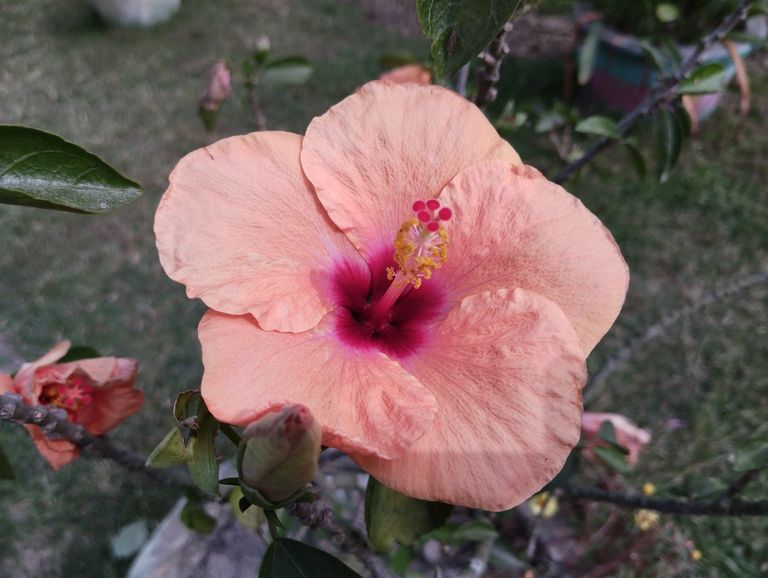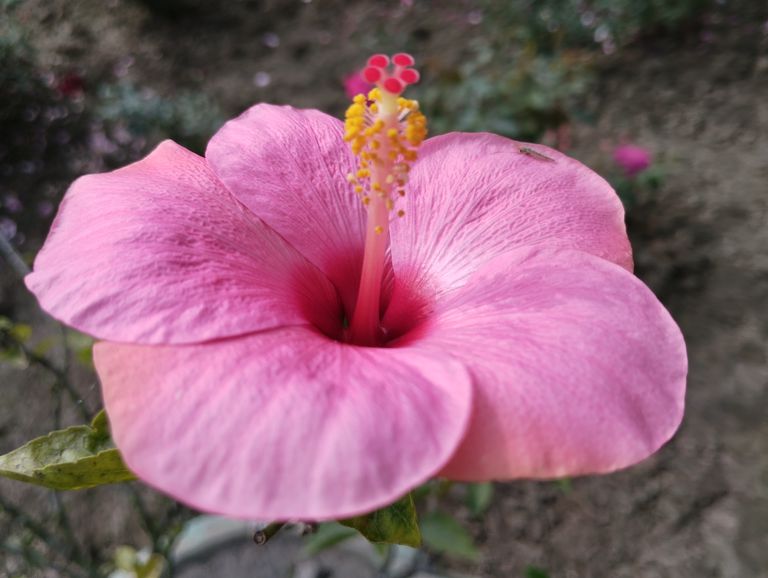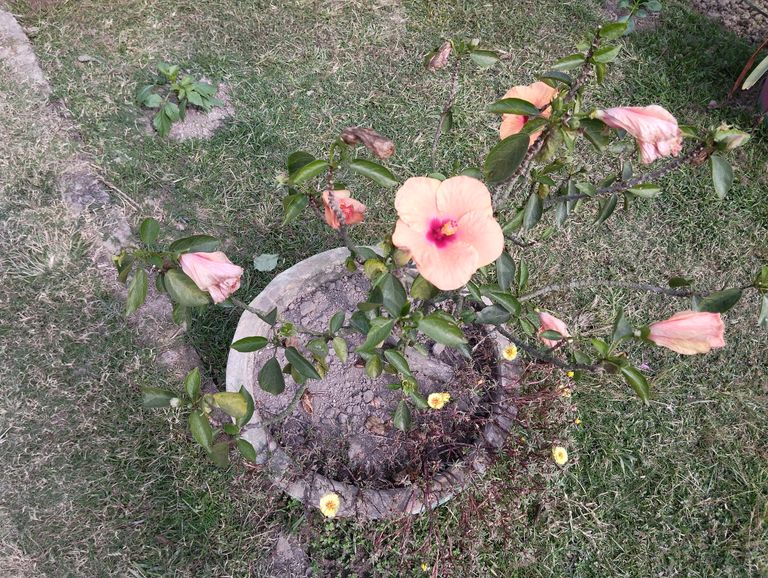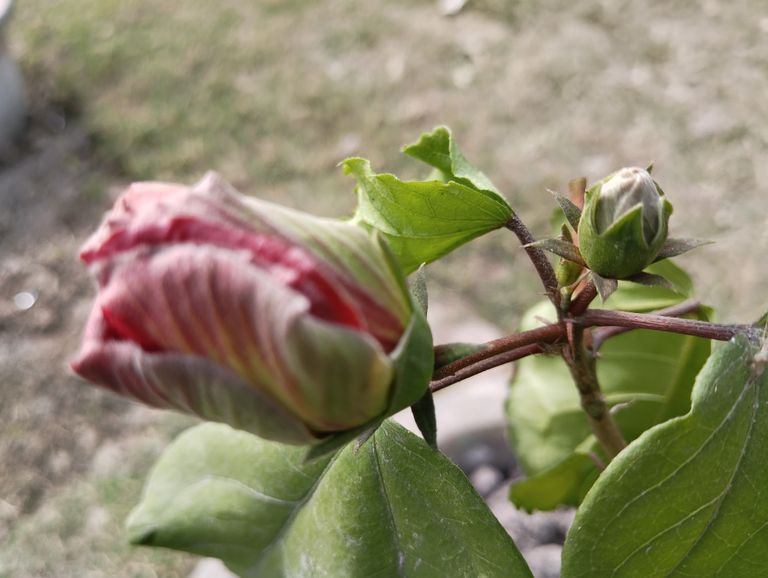
The Timeless Beauty of the Hibiscus flower.
Nature has an incredible way of mesmerizing us with its diverse and vibrant creations, and among these, the hibiscus flower stands out as a symbol of beauty, grace, and resilience. Known as in Bengali, this stunning bloom is cherished for its striking appearance, cultural significance, and versatility. From gardens to traditional rituals, the hibiscus flower's allure has captivated hearts across the world for centuries.
A Splash of Vibrant Colors
One of the most distinctive features of the hibiscus flower is its vibrant palette. These blooms come in a wide range of colors, including fiery red, soft pink, bright yellow, pristine white, and even purple hues. The radiant petals often have a velvety texture, making them appear as if they were painted by the hands of an artist. Among all the varieties, the red hibiscus holds a special place for its bold and captivating charm.
The beauty of the hibiscus lies not just in its colors but also in its unique shape. The flower typically has five large petals that spread out like a delicate fan, encircling a prominent central stigma. This distinct structure gives it an elegant yet exotic look, making it a favorite among garden enthusiasts and floral artists.
A Symbol of Cultural and Spiritual Significance
In many cultures, the hibiscus flower is more than just a pretty bloom; it carries deep spiritual and symbolic meanings. In Hinduism, the red hibiscus is often associated with the goddess Kali and Lord Ganesha. The flower is offered in prayers and rituals, symbolizing purity, devotion, and spiritual energy.
In Polynesian culture, the hibiscus is a symbol of beauty and femininity. Women often tuck a fresh hibiscus flower behind their ear, with the position of the flower indicating their relationship status. Similarly, in Chinese traditions, the hibiscus signifies personal glory and wealth.
A Treasure Trove of Benefits
Beyond its aesthetic appeal, the hibiscus flower is valued for its numerous practical uses. It has been a key ingredient in herbal remedies, skincare, and culinary delights for centuries. The petals are rich in antioxidants and have anti-inflammatory properties, making them an essential component in natural teas, oils, and beauty products. Hibiscus tea, for instance, is known for its tangy flavor and health benefits, including lowering blood pressure, boosting immunity, and improving digestion.
The flower is also used to make hair oils and shampoos, particularly in South Asia, where it is believed to promote hair growth and prevent dandruff. Its vibrant petals can be dried and powdered for use in organic cosmetics, enhancing both skin and hair health naturally.
A Haven for Pollinators
The hibiscus flower is not just a feast for human eyes but also a haven for pollinators. Its bright colors and sweet nectar attract bees, butterflies, and hummingbirds, making it an essential part of any eco-friendly garden. By cultivating hibiscus plants, gardeners can contribute to maintaining the delicate balance of their local ecosystem.


Hibiscus in Art and Literature
The hibiscus flower has long been a source of inspiration for artists, poets, and writers. Its delicate petals and vibrant colors have been immortalized in paintings, poems, and stories. For instance, in Bengali literature, the often symbolizes purity and simplicity, weaving its way into countless works of art and expression.
How to Cultivate Hibiscus Beauty in Your Garden
Growing hibiscus plants is a rewarding experience for gardening enthusiasts. These flowers thrive in tropical and subtropical climates but can also be cultivated in temperate regions with proper care. Here are some tips to nurture hibiscus plants:
Sunlight: Hibiscus loves sunlight. Plant them in a spot that receives at least six hours of direct sunlight daily.
Soil: Use well-draining soil enriched with organic matter to ensure healthy growth.
Watering: While hibiscus plants need regular watering, overwatering should be avoided as it can lead to root rot.
Pruning: Regular pruning encourages new growth and helps maintain the plant’s shape.
Fertilizers: Feed the plant with a balanced fertilizer every few weeks during the growing season for vibrant blooms.
The Timeless Appeal of Hibiscus
The hibiscus flower is more than just a visual delight; it embodies a blend of beauty, utility, and cultural heritage. Whether it's adding a splash of color to a garden, enhancing the flavor of a refreshing tea, or gracing religious rituals with its presence, the hibiscus continues to charm and inspire people across the globe.
In every petal and every bloom, the hibiscus reminds us of the simple yet profound beauty of nature, urging us to pause and appreciate the little wonders that surround us. Let the hibiscus flower inspire you to celebrate life's vibrant hues and embrace the delicate balance of strength and elegance it represents.
How to Create a Beautiful Hibiscus Garden
Hibiscus, also known as China Rose, is a stunning tropical plant admired for its vibrant flowers and lush green leaves. Growing a hibiscus garden is a rewarding experience, whether you're a seasoned gardener or just starting out. This guide will take you through everything you need to know to create a thriving hibiscus garden.
Why Choose Hibiscus for Your Garden?
Hibiscus plants are not only visually appealing but also easy to maintain. They bloom in a variety of colors, including red, pink, yellow, and white. Besides their beauty, hibiscus flowers have cultural and medicinal significance in many regions. They are also excellent for attracting pollinators like bees and butterflies, making them ideal for eco-friendly gardening.
Step 1: Selecting the Right Variety
Hibiscus plants come in two main types:
Tropical Hibiscus (Hibiscus rosa-sinensis): Best for warmer climates, with glossy leaves and large, colorful blooms.
Hardy Hibiscus (Hibiscus moscheutos): Suitable for cooler regions, with larger flowers and a bushy growth pattern.
Choose a variety based on your local climate and aesthetic preferences.
Step 2: Preparing the Soil
Hibiscus thrives in well-drained, slightly acidic soil with a pH of 6.0–6.5. Here’s how to prepare the soil:
Clear the area: Remove weeds, rocks, and debris.
Improve drainage: Mix sand or perlite into the soil if it’s clay-heavy.
Enrich the soil: Add compost or organic matter to provide nutrients.
Step 3: Finding the Perfect Spot
Hibiscus plants need plenty of sunlight to bloom abundantly. Choose a location that gets at least 6–8 hours of direct sunlight daily. However, in extremely hot climates, partial afternoon shade can protect the plant from scorching.
Step 4: Planting Hibiscus
Spacing: Space plants 3–4 feet apart to allow for proper air circulation.
Planting depth: Dig a hole twice as wide as the root ball but no deeper. Place the plant in the hole, ensuring the top of the root ball is level with the soil surface.
Watering: Water thoroughly after planting to help the roots settle.
Step 5: Watering and Fertilizing
Hibiscus plants love water but dislike waterlogged soil. Maintain a consistent watering schedule to keep the soil moist but not soggy. During the growing season (spring to fall), feed the plants with a balanced fertilizer rich in nitrogen, phosphorus, and potassium. A slow-release fertilizer is ideal for long-term nutrition.
Step 6: Pruning and Maintenance
Regular pruning promotes healthy growth and abundant flowering.
Prune in early spring: Remove dead or weak branches to shape the plant.
Deadhead spent flowers: This encourages new blooms and prevents the plant from wasting energy on seed production.
Step 7: Protecting from Pests and Diseases
Hibiscus plants are susceptible to pests like aphids, spider mites, and whiteflies.
Use organic sprays: Neem oil or insecticidal soap works well to control pests.
Prevent diseases: Avoid overwatering and ensure good air circulation to prevent fungal issues like root rot or leaf spots.

Step 8: Mulching and Winter Care
Mulching: Apply a 2–3 inch layer of organic mulch around the base of the plants. Mulch retains soil moisture and suppresses weeds.
Winter care: For tropical varieties, move potted plants indoors during winter. Hardy varieties can tolerate frost but benefit from additional mulch for insulation.
Creative Ideas for Hibiscus Gardens
Hedge or Border: Use hibiscus plants to create a colorful hedge or border.
Potted Hibiscus: Grow hibiscus in decorative pots for patios and balconies.
Mixed Flower Beds: Combine hibiscus with other tropical plants like bougainvillea or plumeria for a vibrant display.
Benefits of a Hibiscus Garden
Aesthetic Appeal: Bright, cheerful flowers enhance the beauty of any space.
Environmental Contribution: Hibiscus plants support pollinators and improve air quality.
Therapeutic Value: Spending time in a hibiscus garden can reduce stress and boost mental well-being.
Creating a hibiscus garden is a fulfilling project that brings beauty and tranquility to your home. With proper care, your garden will flourish with vivid blooms and lush greenery, transforming your space into a tropical paradise.
How to Make Hibiscus Cuttings: A Step-by-Step Guide
Hibiscus, also known as joba in Bengali, is a vibrant flowering plant widely loved for its colorful blossoms and tropical appeal. Propagating hibiscus through cuttings is an easy and effective way to grow new plants. This method ensures that the new plants retain the parent plant's characteristics. Here's a comprehensive guide on how to make hibiscus cuttings.
Why Propagate Hibiscus through Cuttings?
True-to-Type Plants: The cuttings grow into plants identical to the parent plant.
Cost-Effective: It's a budget-friendly method to multiply your garden's beauty.
Quick Growth: Cuttings root faster and grow more quickly compared to seeds.
Tools and Materials Needed:
A healthy hibiscus plant
A pair of sharp pruning shears or scissors
A small container or pot
Potting mix (rich in organic material and well-draining)
Rooting hormone (optional but helpful)
Clean water
A plastic bag or transparent cover (for humidity)
Step-by-Step Process:
Select a Healthy Parent Plant
Choose a healthy and disease-free hibiscus plant with vibrant foliage and flowers. This ensures the best chance of success for your cuttings.
Cut the Stem
Look for a branch that is semi-hardwood, meaning it is not too young or too old.
Cut a stem about 6-8 inches (15-20 cm) long, just below a leaf node. Ensure your shears are clean to prevent infections.
Remove Extra Leaves
Strip off the leaves from the lower half of the stem to reduce water loss.
Leave 2-3 leaves at the top to support photosynthesis.
Prepare the Cutting
If using a rooting hormone, dip the cut end of the stem into it. This step is optional but can speed up the rooting process.
Make sure the cut is clean and not jagged for optimal root growth.
Plant the Cutting
Fill a container with a well-draining potting mix. You can mix garden soil with sand and compost for better drainage.
Create a small hole in the soil and insert the cutting about 2-3 inches deep. Firmly press the soil around it to hold the cutting in place.
Water the Cutting
Water the cutting thoroughly but avoid overwatering, as it can lead to rotting.
Ensure the soil remains moist but not soggy.
Provide Humidity
Cover the pot with a plastic bag or a transparent cover to create a greenhouse effect. This traps moisture and promotes faster rooting.
Keep the cutting in a warm, shaded spot with indirect sunlight.
Monitor and Wait
Check the cutting regularly for signs of growth. Water it as needed to keep the soil moist.
Roots usually develop within 4-6 weeks. Gently tug the cutting after a month to check for resistance, indicating root growth.
Transplanting the Rooted Cutting
Once the roots are about 1-2 inches long and the cutting has new growth, it's time to transplant it:
Prepare a larger pot or a spot in your garden with nutrient-rich soil.
Gently remove the rooted cutting, taking care not to damage the roots.
Plant it in its new location and water thoroughly.
Tips for Success:
Season Matters: The best time to take hibiscus cuttings is during the spring or early summer when the plant is actively growing.
Sterilize Tools: Clean your tools with alcohol to prevent the spread of diseases.
Patience Pays: Some cuttings take longer to root depending on the variety and conditions.
Benefits of Growing Hibiscus from Cuttings
Eco-Friendly Gardening: Reduces the need to buy new plants.
Decorative Appeal: Hibiscus flowers are perfect for beautifying gardens, balconies, and patios.
Cultural Significance: In many cultures, hibiscus holds religious and ornamental value.
Hibiscus Tea: A Blossoming Elixir for Health and Wellness
Hibiscus tea, made from the vibrant petals of the Hibiscus sabdariffa plant, is a popular herbal infusion enjoyed worldwide for its delightful taste and numerous health benefits. Known for its striking ruby-red color, tangy flavor, and refreshing qualities, hibiscus tea has earned a special place in the world of herbal remedies. In this blog, we’ll explore the origins, benefits, preparation methods, and cultural significance of this enchanting beverage.
The Origins of Hibiscus Tea
Hibiscus tea has a rich history rooted in ancient cultures. Its origin is often linked to Africa, where hibiscus plants thrive in warm climates. The tea was traditionally brewed for medicinal purposes and as a refreshing drink to combat the scorching heat. Over time, hibiscus tea made its way to the Middle East, Asia, and the Caribbean, where it became an integral part of local traditions and cuisines.
In Egypt, hibiscus tea is known as “karkade” and has been enjoyed since the time of the Pharaohs. It was believed to have cooling properties and was often used in royal ceremonies. Today, this herbal tea is cherished globally, not just for its taste but also for its numerous health benefits.
Health Benefits of Hibiscus Tea
Hibiscus tea is more than just a delicious drink. It is packed with antioxidants, vitamins, and minerals that contribute to overall health and wellness. Below are some of its remarkable benefits:
Rich in Antioxidants
Hibiscus tea is a powerhouse of antioxidants like flavonoids and anthocyanins, which help combat free radicals in the body. This can reduce oxidative stress and prevent cell damage, promoting healthier skin and a stronger immune system.
Supports Heart Health
One of the most celebrated benefits of hibiscus tea is its ability to lower blood pressure. Studies suggest that regular consumption can reduce both systolic and diastolic blood pressure, making it an excellent natural remedy for hypertension. Additionally, it may help lower LDL (bad cholesterol) levels, further supporting cardiovascular health.
Boosts Liver Function
Hibiscus tea is known to promote liver health by aiding in detoxification and improving enzyme function. A healthy liver is essential for metabolizing nutrients and removing toxins from the body.
Aids in Weight Management
The natural compounds in hibiscus tea can help regulate metabolism, reduce fat accumulation, and improve digestion. Its diuretic properties also aid in reducing water retention, making it a popular choice for those on a weight-loss journey.
Enhances Skin Health
The anti-inflammatory and antioxidant properties of hibiscus tea can reduce acne, soothe skin irritation, and promote a natural glow. The high vitamin C content helps in collagen production, keeping skin firm and youthful.
Supports Digestive Health
Hibiscus tea has mild laxative properties that can improve bowel movements and reduce bloating. It also aids in maintaining a healthy gut environment.
How to Make Hibiscus Tea
Making hibiscus tea is simple and can be customized to suit your taste preferences. Here’s a quick recipe:
Ingredients:
1-2 tablespoons of dried hibiscus petals
2 cups of water
Honey or sugar (optional)
Lemon juice (optional)
Instructions:
Bring the water to a boil.
Add the dried hibiscus petals to the boiling water.
Reduce the heat and let the petals steep for 5-10 minutes, depending on how strong you want the flavor.
Strain the tea into a cup and sweeten with honey or sugar if desired.
Add a splash of lemon juice for a zesty twist and enjoy it hot or cold.
Tip: To make iced hibiscus tea, let the brewed tea cool to room temperature before refrigerating it. Serve over ice with a slice of lemon for a refreshing summer drink.
Cultural Significance of Hibiscus Tea
Hibiscus tea holds cultural importance in many countries. In Sudan and Egypt, it is a staple at weddings and other celebrations. In Jamaica, the tea is popularly known as “sorrel” and is often spiced with ginger, cinnamon, and cloves during the holiday season.
In Asia, hibiscus tea is used in Ayurveda and traditional Chinese medicine to treat various ailments, including inflammation and fever. Its vibrant color and tangy flavor make it a symbol of vitality and renewal in many cultures.
Precautions and Side Effects
While hibiscus tea offers numerous benefits, it’s essential to consume it in moderation. Overconsumption may lead to a significant drop in blood pressure, which can be dangerous for individuals with low blood pressure. Pregnant women and those on medication should consult a doctor before incorporating hibiscus tea into their routine.
Conclusion
Hibiscus tea is a delightful and healthful beverage that has stood the test of time. Its myriad benefits, coupled with its vibrant color and tangy flavor, make it a favorite among tea lovers worldwide. Whether you enjoy it as a refreshing iced tea in summer or a warm cup during the colder months, hibiscus tea is a versatile drink that caters to both the palate and the body.